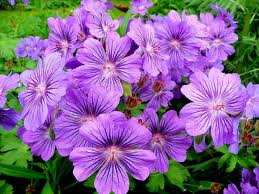Geranium
This group of hardy perennials is found in the temperature regions of Europe, North America and other various parts of the world. This group shouldn't be confused with the "Geraniums" that are grown in pots for greenhouse or home decoration, or for summer bedding; the name "Geranium" is the common name for the plants known botanically as Pelargoniums (go see). The Geraniums we will discuss here are commonly known as Cranesbills. These plants range in height between the varieties from 1 to 4 feet. G. phaeum 'Album' is a pretty variety with light green leaves, which are divided into 7 to 9 lobes. Its white flowers are larger than the darker-flowered varieties. They grow in loose, branched clusters from late spring to summer. G. psilostemon has medium green leaves that are deeply divided into 7 lobes; they turn red in the fall. The cup-shaped, single, hot pink flowers have black centers and are abundantly produced in mid-summer. G. pratense 'Mrs. Kendall Clark' is a vigorous growing plant with dark green leaves that are divided into 7 to 9 thin, toothed and divided segments. In the summer, this plant produces an abundance of large, saucer-shaped, pale violet-blue flowers in clusters above the foliage. G. renardii has rounded, green leaves with 5 to 7 toothed lobes. They are wrinkly and softly fuzzy. The single flowers are borne in loose clusters in early to mid-summer. They are white or blue tinted with maroon-purple veins. G. magnificum has hairy leaves divided into 9 to 11 rounded lobes. In early summer, large, cup-shaped flowers are produced in small clusters. The flowers are rich violet-blue veined with a darker shade. G. wallichianum 'Buxton's Variety' has large, cup-shaped flowers from mid-summer to fall. The flowers are blue or blue-purple with white centers. Its leaves are mid- to bright green. Other varieties will be mentioned below.
Pot Cultivation
They can be grown in ordinary, fertile garden soil that has excellent drainage, in sun or light shade. G. nodosum should be grown in complete shade.
Propagation
Most Geraniums are ordinarily increased by dividing them in the spring or fall, but seeds can also be sown at those times of the year. Semi-ripe cuttings are sometimes used in the summer. G. 'Ann Folkard' only forms one roostock each, therefore cannot be divided. The best way to propagate this variety is by cuttings taken of side shoots in the summer.
 |
G. renardii |
VARIETIES
- G. argenteum;
- G. cinereum;
- G. Farreri;
- G. Pylzowianum;
- G. sanguineum prostratum;
- G. Wallichianum & var. Buxton's Variety;
- G. Endressii;
- G. grandiflorum & var.alpinum;
- G. ibericum;
- G. macrorrhizum & var. Ingwersen's Variety;
- G. pratense & var. Mrs. Kendall Clark;
- G. phaeum & var. album;
- G. oxonianum & var. Winscombe, Southcombe Star, Wargrave Pink;
- G. psilostemon;
- G. sylvaticum & var. Mayflower;
- G. nodosum;
- G. clarkei & var. Kashmir White;
- G. renardii;
- G. endresii;
- G. asphodeloides;
- G 'Ann Folkard';
- G. Himalayense & var. Gravetye;
- G. magnificum;
- G. 'Johnson's Blue';
- G. erianthum.





